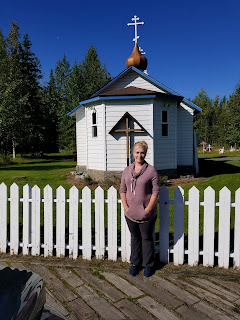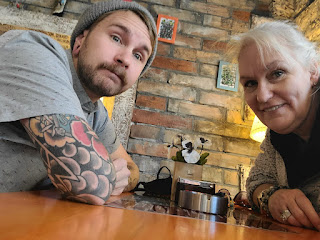Dachau Consentration Camp
I have visited Dachau twice, the first time on a sister
vacation to Germany and the second when my daughter and I visited Germany for
her high school graduation trip.
 |
| Memorial of the different badges that prisoners wore. |
Dachau was one of the first concentration camps established
by the Nazis in 1933 as time went on not only Jews but also Jehovah Witnesses,
Gypsies, homosexuals and anyone else the Nazi party deemed inferior were
brought to Dachau. After Kristallnacht in November 1938 the number of Jews
increased considerably. In 1942 when the systematic extermination of Jews began
many Jewish prisoners were transferred from Dachau to the mass extermination
camps located in Poland.
From the moment you arrive at Dachau concentration camp you
feel a sense of sadness. On both trips we first walked to the area where the
train would stop and prisoners would be unloaded and sorted, as you stand there
you are filled with such a feeling of desperation, thinking how frightened
these people must have been upon their arrival. From here we walked up to the
Jourhouse ( gate house)and through the gates into the camp, on the entrance
gate is an iron sign that reads Arbeit Mach Frei (Work will Set you Free)
sadly, this was not the case, instead it was part of the propaganda to make the
camp look like a labor and re-education camp to outsiders. As you stand inside the camp, you are able to
see the guard towers, the barbwire fences and the ditches dug to keep people back from the fence line, we were told
that prisoners were shot if they got to close to the ditch.
We walked to the roll call square where prisoners were
forced to assemble each morning and evening and stand through roll calls that
could last for hours. Standing here the prisoners would have seen the
inscription that read “There is one road to freedom, obedience, honesty, cleanliness,
sobriety, diligence, orderliness, self-sacrifice, truthfulness and love of the
fatherland. I recall overhearing a tour guide saying how the prisoners were
expected to keep everything clean at all times, a feat that would have been
impossible given the large amount of people who were forced to share very small
quarters.
As you walk through the bunkers, a place where political prisoners were held and also where prisoners were taken as punishment and often tortured and many executed it is hard to comprehend that not long ago people were being kept here and treated in such an unimaginable way.
 The cells where the prisoners were kept were very small, sometimes they were split in half and prisoners were kept in an area so tiny they could not sit or lie down, instead they were forced to stand in the dark for days at a time.
The cells where the prisoners were kept were very small, sometimes they were split in half and prisoners were kept in an area so tiny they could not sit or lie down, instead they were forced to stand in the dark for days at a time.
When it was operating at a concentration camp Dachau had 34 barracks that prisoners were housed in, today there are concrete slabs to mark the spots with two reconstructed barracks allowing visitors to see the conditions prisoners lived in. The bunks are small, very close together and stacked as high as they can go, people were forced to find a sleeping spot wherever they could. The overcrowding, malnutrition and lack of sanitation lead to sick prisoners, many of who died from disease.
Dachau has a gas chamber, many say it was never used while some insist that it was used at least a few times. Either way when you stand in the middle of this room it is literally difficult to breath, the thoughts of how terrified people would have been, being herded into a room like this, told it was a shower and then having it fill with poison gas as they suffocated to death is almost to much to think about, it brings tears to my eyes even remembering the feeling I had both times I stood here.
Visiting Dachau is a heart wrenching experience, the tour either self guided or with a tour guide is full of information that will give you a better sense of the shear brutality that occurred here.
I am pleased that Dachau does not charge an entrance fee, there are signs that say they will not profit from the suffering of those who were imprisoned here. There are however several donation sites that help to keep the memorial open, on both of our visits a large donation was left, it is important that this memorial continue to operate offering people a chance to see the horrors of what happened so we can ensure Never Again



















Comments
Post a Comment